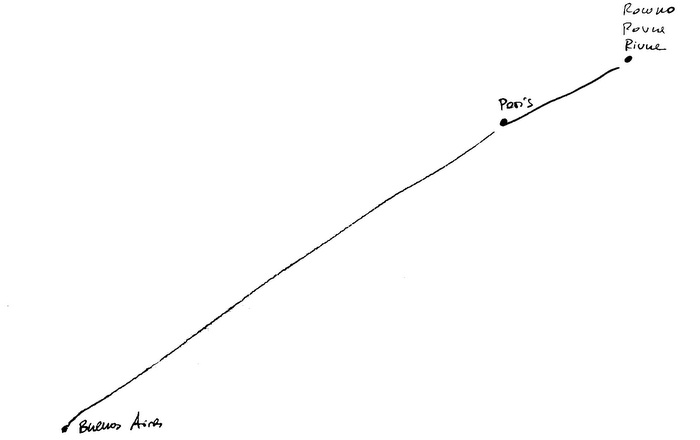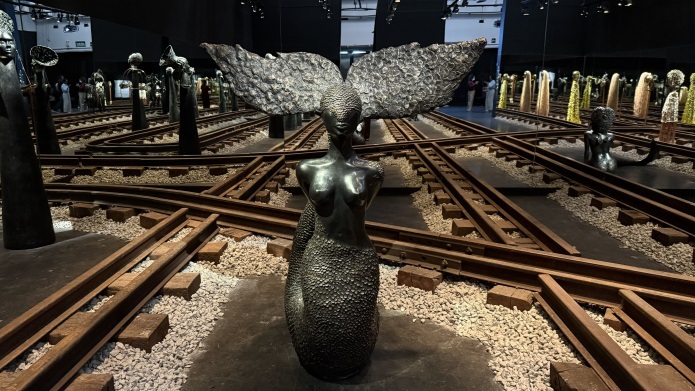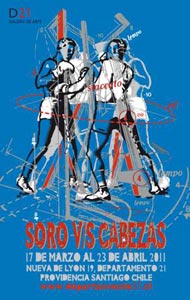
Chilean artists Rodrigo Cabezas and Mario Soro have put together an exhibition of unpublished artwork at the D21 gallery displaying great part of the concerns and obsessions the two shared back in the 1980s when they were students at the Art School of the Catholic University.
The exhibition is an exchange mixing aesthetic and conceptual precedents, an encounter bringing to light the tension inside their respective works of art. As a way to recover the history not registered in the official history of the visual arts in Chile, Cabezas and Soro review the material of multiple stage exercises they made together two decades ago during the engraving workshop of professor and artist Eduardo Vilches, the drawing workshop and their own thoughts on the displacement of such means. Back then, they made art actions, public presentations and performances similar to Joseph Beuys’ practices which took western art and free and interdisciplinary thinking promoted by the Fluxus group in the 1960s and 70s by surprise.
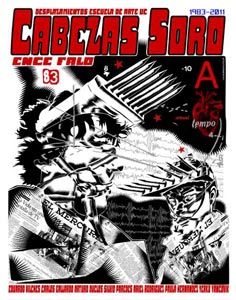 The two artists were accompanied by their contemporary Arturo Duclos and Silvio Paredes (who would later join the musical group Electrodomesticos); other creators circulating at the time were Alicia Villarreal, Ariel Rodriguez, Yerko Yankovic, Paula Hernandez and Paulina Aguilar. Chile was in the middle of the dictatorship, the city was under total military control, nevertheless, their activities seemed so weird and coming out of nowhere, that the public force was never suspicious of them, neither were they associated to any kind of activism. They were, however, thinking about Chile, their powers, their molds, their stereotypes and the difficult times running back then.
The two artists were accompanied by their contemporary Arturo Duclos and Silvio Paredes (who would later join the musical group Electrodomesticos); other creators circulating at the time were Alicia Villarreal, Ariel Rodriguez, Yerko Yankovic, Paula Hernandez and Paulina Aguilar. Chile was in the middle of the dictatorship, the city was under total military control, nevertheless, their activities seemed so weird and coming out of nowhere, that the public force was never suspicious of them, neither were they associated to any kind of activism. They were, however, thinking about Chile, their powers, their molds, their stereotypes and the difficult times running back then.
In this process of historical review, Rodrigo Cabezas has gone back to black and white, and to the aesthetics of his emblematic exhibition La moda mata (Fashion Kills), when he was part of a collective together with Bruna Truffa and Sebastian Leyton. Always with parody as tool of expression, he will present in D21 a series or, even better, a “decima” (a ten-verse poem), made up by 10 large-size illustrations inspired on typical Chilean graphic models, such as Lira Popular, Ramona Parra murals, headlines, posters of singers from the 1970s. The unwitting collective speaks on its own in this sort of installation, with personalities like Violeta Parra, Victor Jara, Salvador Allende, Gabriela Mistral, Pablo Neruda, Roberto Matta, Orlando Letelier, Jaime Guzman and even President Piñera.
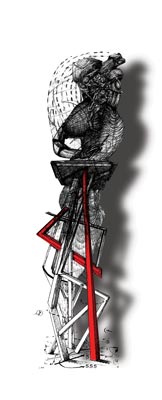 Mario Soro is known for his public interventions and stages of critical views about Modernity and control mechanisms. This is the side of his work that he has ironically called “public virtues”, but always coexisting and under constant pressure are his “private vices” that correspond to the practice of drawing his own “perverse imaginary” closely linked to the historicity of his artistic collaborations with Rodrigo Cabezas. It is at this point when precedents, drives, symbolic tools and aesthetic options come together. Mario Soro makes incursions into drawing life-size undecipherable characters in canvas.
Mario Soro is known for his public interventions and stages of critical views about Modernity and control mechanisms. This is the side of his work that he has ironically called “public virtues”, but always coexisting and under constant pressure are his “private vices” that correspond to the practice of drawing his own “perverse imaginary” closely linked to the historicity of his artistic collaborations with Rodrigo Cabezas. It is at this point when precedents, drives, symbolic tools and aesthetic options come together. Mario Soro makes incursions into drawing life-size undecipherable characters in canvas.
Mario Soro expands that universe to a video animation coming from 25-meters of ballpoint pen drawings made as he traveled to Valparaiso to teach some courses. The sequence shows typical elements of his iconography such as fingerprints, illustrating control systems used by power on bodies, the human being, etc. Likewise, it portrays other topics such as delinquency and bankruptcy of education systems.
As his actions in the 1980s did, breaking rules, turning the spotlight on the Catholic University, Rodrigo Cabezas and Mario Soro propose works of art for reflection. The complement between each other will be transfer and addition, placing the sense of collaboration and artistic collectives from yesterday and today as true values.
Source: Press release sent by Elisa Cardenas



